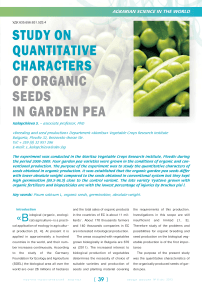Study on quantitative characters of organic seeds in garden pea
Автор: Kalapchieva S.
Журнал: Овощи России @vegetables
Рубрика: Аграрная наука в мире
Статья в выпуске: 4 (21), 2013 года.
Бесплатный доступ
The experiment was conducted in the Maritsa Vegetable Crops Research Institute, Plovdiv during the period 2008-2009. Four garden pea varieties were grown in the conditions of organic and conventional production. The purpose of the experiment was to study the quantitative characters of seeds obtained in organic production. It was established that the organic garden pea seeds differ with lower absolute weight compared to the seeds obtained in conventional system but they kept high germination (89,5-96,5) close to the control variant. The late variety Vyatovo grown with organic fertilizers and biopesticides are with the lowest percentage of injuries by Bruchus pisi l.
Pisum sativum l, organic seeds, germination, absolute weight
Короткий адрес: https://sciup.org/14025219
IDR: 14025219 | УДК: 635.656:631.523.4
Текст статьи Study on quantitative characters of organic seeds in garden pea
and the total sales of organic products
the requirements of this production.
«B
iological (organic, ecological) agriculture» is a practi-
in the countries of EC is about 11 mil-
Investigations in this scope are still
liards . About 170 thousands farmers
insufficient and limited [1, 3].
cal application of ecology in agricultur- and 140 thousands companies in EC
Therefore study of the problems and al production [3, 4]. At present it is are interested in biological production.
possibilities for organic breeding and applied in approximately a hundred countries in the world, and their number increases continuously. According to the study of the Germany Foundation for Ecology and Agriculture (SOEL) the biological area all over the world are over 26 millions of hectares
The areas occupied with vegetables grown biologically in Bulgaria are 670 ха (2011). The increased interest to biological production of vegetables determines the necessity of choice of suitable varieties and production of seeds and planting material covering seed production on the biological vegetable production is of the first importance
The purpose of the present study was the quantitative characteristics of the organically produced seeds of garden pea.
Material and methods
The experiment was performed in the experimental plot of area of 625 m2 of the Maritsa Vegetable Crop Research Institute-Plovdiv, Bulgaria during the period 2009-2010 on four garden pea accessions: the early varieties Pulpudeva and Iskar, the mid-early variety Skinado, and the late variety Vyatovo. The sowing was made by scheme 80+20+40+20/4-5 cm. The experiment was conducted in 5 variants with 4 replications.
Four systems of organic production of garden peas were studied: the Ist variant – growing plants in natural soil fertility without using plant-protection products; the IInd variant – growing in natural soil fertility, using biopesticides for plant pro- tection; the IIIrd variant – growing plants by fertilization with organic products authorized for use in organic production without the use of biopesticides for plant protection and the IVth variant – growing plants by fertilization with organic products authorized for use in organic production and use of biopesticides for plant protection. The control variant of the experiment is the conventional production – the Vth variant – growing through the use of herbicides, mineral fertilization and plant protection by fungicides and insecticides of chemical origin.
The fertilization rates with biohumus have been determined in the agrochemical laboratory of the Maritsa Vegetable Crop Research Institute. Specification of fertilizer rates was made according to the reserves of soil nutrient substances and the biological requirements of garden pea – 200 l/da biohumus for the third and the fourth variants before flowering.
The plant protection in the second and the fourth variant was realized by conducting of double bio-insecticides treated with Rotena 0.3% and Piros 0.08% against Bruchus pisi L. The chemical products included in the scheme of the Vth variant: are the following: Decis 2.5 EC 0.04% (active ingredient – deltametrin), Nurele Dursban 0.07% (active ingredients – cipermetrin+chlor-pirifosetil) and Mospilan 20 SP 0.0125% (active ingredient – acetamiprid).
The following characters were stud-
Table 1. Seed characteristics obtained in organic production systems
|
Variety Variant |
Absolute seed weight, g |
Seed germination, % |
Seed number per plant plump non-plump |
Average number of seeds/pod |
|
|
PULPUDEVA |
|||||
|
Control |
166.25 |
96.00 |
45.13 |
6.38 |
4.63 |
|
Variant I |
164.23 |
94.00 |
51.50 |
10.83 |
5.00 |
|
Variant II |
173.10 |
96.50 |
54.38 |
11.50 |
5.00 |
|
Variant III |
147.45 |
90.75 |
61.75 |
7.50 |
5.00 |
|
Variant IV |
170.78 |
94.25 |
58.13 |
9.50 |
4.50 |
|
ISKAR |
|||||
|
Control |
200.86 |
96.25 |
51.38 |
9.00 |
5.63 |
|
Variant I |
148.50 |
94.25 |
48.88 |
11.13 |
5.13 |
|
Variant II |
160.74 |
95.75 |
49.88 |
9.23 |
5.13 |
|
Variant III |
153.25 |
95.50 |
52.15 |
10.13 |
5.00 |
|
Variant IV |
169.15 |
95.00 |
52.25 |
10.93 |
5.00 |
|
SKINADO |
|||||
|
Control |
152.79 |
94.50 |
63.50 |
3.35 |
6.13 |
|
Variant I |
117.90 |
90.75 |
53.75 |
12.50 |
6.00 |
|
Variant II |
125.38 |
93.50 |
53.13 |
8.13 |
5.50 |
|
Variant III |
123,58 |
89.50 |
59.63 |
6.38 |
6.25 |
|
Variant IV |
127.80 |
92.50 |
54.25 |
3.75 |
5.63 |
|
VYATOVO |
|||||
|
Control |
128.80 |
93.75 |
55.50 |
5.63 |
6.25 |
|
Variant I |
127.93 |
93.75 |
61.50 |
16.88 |
5.63 |
|
Variant II |
134.38 |
96.50 |
69.75 |
10.00 |
6.00 |
|
Variant III |
125.83 |
92.75 |
69.00 |
8.88 |
6.13 |
|
Variant IV |
131.30 |
94.75 |
70.13 |
6.88 |
6.38 |
Control – conventional production, Variant I – natural soil fertility without the use of plant-protection products, Variant II – natural soil fertility, using biopesticides, Variant III – fertilization with biohumus without the use of biopesticides, Variant IV – fertilization with biohumus and plant protection with biopesticides.
Table 2. Analysis of variance of garden pea seeds obtained in different organic systems
|
Sources of variation |
Degree of freedom |
Absolute seed weight |
Seed germination |
Seed number per plant |
Average number of seeds/pod |
|
|
plump |
non-plump |
|||||
|
Genotype |
3 |
6180.6 n.s. |
18.1 ** |
745.6 *** |
42.3 *‘ |
7.0 *** |
|
Variant |
4 |
3859.6 n.s. |
15.8 ** |
140.5 n.s. |
103.1 *** |
0.3 n.s. |
|
Genotype х Variant |
12 |
6609.7 n.s. |
2.6 n.s. |
93.2 n.s. |
17.3 n.s. |
0.3 n.s. |
|
Residual |
60 |
5822.9 |
3.5 |
74.4 |
16.2 |
0.2 |
*** P 0.001, ** – P 0.01, * – P 0.05, ns – not significant ied: absolute seed weight (g), seed germination (%), number of plump and nonplump seeds per plant, average number of seeds per pod and the percentage of seeds infected by B. pisi [5]. The absolute seed weight was analyzed for 1000 dry seeds. The seed germination was recorded in two samples of 100 seeds (25 seeds from a repetition) on the 12th day of the experiment.
The obtained experimental data was statistically processed using computer software MS Excel (Microsoft Office 2002) for Windows XP. The influence of the variation factors on the studied characters has been studied.
Results and discussion
The studied characters of the seeds obtained in different systems for organic production show the lower values of the absolute weight and the germination in the varieties Iskar and Skinado for all variants of organic production compared to the control (Table 1). The higher values of the two characters for the variety Vyatovo were observed in the second and the forth variants. The higher values of the absolute seed weight for the same variants were recorded in the variety Pulpudeva. The amount of the full grains varies in different varieties and variants. The seed number in the varieties Pulpudeva and Vyatovo was higher in the
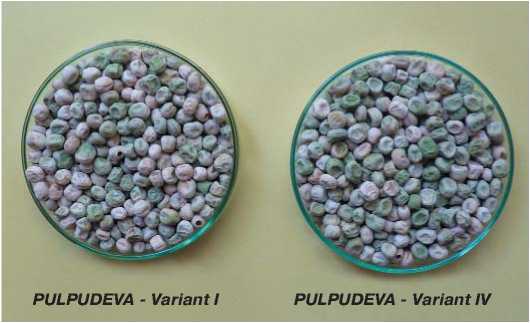
PULPUDEVA - Variant I
PULPUDEVA - Variant IV
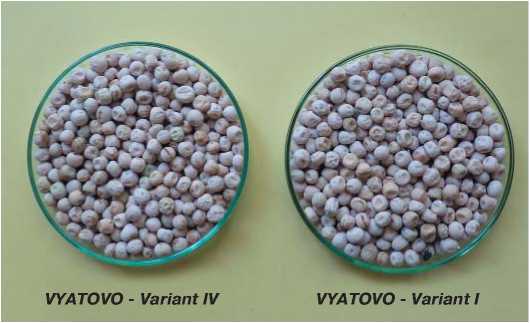
VYATOVO - Variant IV
VYATOVO - Variant I
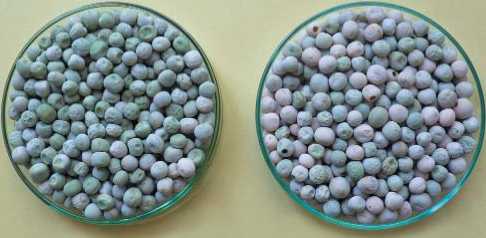
ISKAR - Variant IV
ISKAR - Variant I

SKINADO - Variant IV
SKINADO - Variant I
Table 2. Analysis of variance of garden pea seeds obtained in different organic systems
Significant differences for germination, the full and non full grains and the average seed number in the pod among the studied garden pea genotypes were established by two-way analysis of variance (Table 2). The variation of these characters is as a result of the genetic differences of the studied materials and it varies from 7. 37 to 57.24% (Table 3). The different organic variants of growing have an effect on the seed germination (28.78%) and the amount of non full grains (23.99 %) (Table 3). There are no proven differences in the interaction genotype x variant for all characters.
The percentage of the seeds damaged by Bruchus pisi. L. in the organic systems of production for all garden pea genotypes is higher than in the conventional growing (Figure 1). The early varieties Pulpudeva and Iskar are the most susceptible to the studied pest (62.2% and 75.3%, respectively), followed by the mid-early variety Scinado. In the traditional system for organic production (with biohumus and biopesticides), the late variety Vyatovo shows the low susceptibility (27.1 %) to the B. pisi L. The lower percentage of seed infestation by B. pisi L in the systems of organic production is recorded for all studied varieties in the variants II and IV where the bio-insecticides were applied.
Conclusions
The organic seeds of garden pea have the lower absolute weight com-
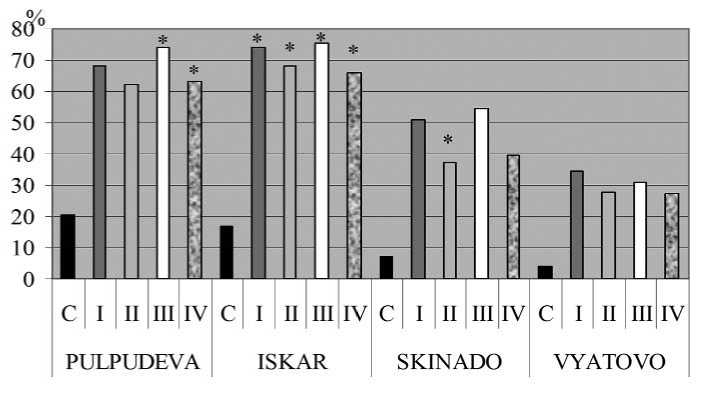
C (Control) – conventional production, I (Variant I) – natural soil fertility without the use of plant-protection products, II (Variant II) – natural soil fertility, using biopesticides, III (Variant III) – fertilization with biohumus without the use of biopesticides, IV (Variant IV) – fertilization with biohumus and plant protection with biopesticides.
Fig.1. Percentage of the seeds damaged by Bruchus pisi L. of the garden pea varieties in different systems of organic production
pared to the seeds produced in conventional systems, but the germination was high (89.50 % – 96.50%) regardless of the variant of production.
The lowest percentage of seeds damaged by Bruchus pisi. L. was recorded in the late variety Vyatovo grown in the IVth variant (fertilization by organic products and application of biopesticides).
Список литературы Study on quantitative characters of organic seeds in garden pea
- Antonova, G. Study on yield and quality characters in cabbage seed obtained in the conditions of organic trial. Cruciferae Newsletter.-2012.-31-P. 22-25.
- Bonina, J., Cantliffe, D. J. Seed Production and Seed Sources of Organic Vegetables. -2004.-HS 981. EDIS. http://edis.ifas.ufl.edu
- Kalapchieva Sl., St. Masheva, V. Yankova. Identification of initial material for organic breeding in garden pea. Bulletin of the Transilvania University of Brasov.-2011.-4(53).-P. 81-88.
- Lammerts van Bueren, E.T., Struik, P.C.,Jacobsen, E. Organic propagation of seed and planting material an overview of problems and challenges for research NJAS Wageningen Journal of Life Sciences.-2003.-51, 3.-P.263-277.
- Mixailova, P., F. Straka, I. Apostolov: Растително-защитна прогноза и сигнализация (Plant protection prognosis and signalization), Zemizdat, Sofia.-1982.

